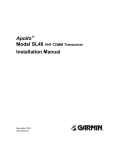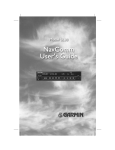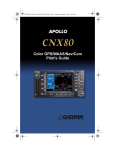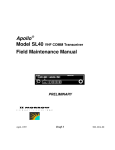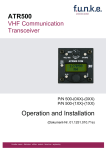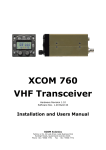Download Garmin SL40 Marine Radio User Manual
Transcript
No part of this document may be reproduced in any form or by any means without the express written consent of Garmin AT, Inc. II Morrow, Garmin AT, and Apollo are trademarks of Garmin AT, Inc. © 2003 by Garmin AT, Inc. All rights reserved. Printed in the U.S.A. Garmin AT, Inc. 2345 Turner Road S.E. Salem, OR 97302 U.S.A. Toll Free Canada Toll Free International FAX 800.525.6726 800.654.3415 503.391.3411 503.364.2138 Visit our web page at http://www.garminat.com Send comments about this manual by e-mail to: [email protected] Welcome ... Welcome to a new era of aviation communication. Once again, Garmin AT, Inc. has set new standards in features and ease of use for the general aviation public. The Apollo SL40 is a VHF Communications Transceiver for use by the aviation pilot. Packaged in a new slim form factor that helps you get the most out of limited panel real estate without limiting features and performance. The Apollo SL40 is unequaled in providing the features, level of performance, and reliability that aviation users expect. The Apollo slim line series of avionics sets a precedent that will be the standard that all other avionics will be compared to. You can be confident in knowing that you are the owner of the state-of-the-art in aviation communication. Our products are built to last and to allow for upgrading as your needs change in the future. The SL40 is also packaged in configurations to meet the needs of customers for base station and mobile applications. Contact the Garmin AT factory for more details. i History of Revisions December 1996 March 1997 June 1998 September 2003 Original Release Rev. -01 Rev. -02 Rev. -02a Ordering Information To receive additional copies of the Apollo SL40 User’s Guide, order part #560-0954-02a. The Apollo SL40 Installation Guide is part #560-0956-xx. ii Table of Contents Welcome ... · · · · · · · · · · · · · · · · · · · · · · · i History of Revisions · · · · · · · · · · · · · · · · · · ii Ordering Information · · · · · · · · · · · · · · · · · ii Introduction · · · · · · · · · · · · · · · · · · · · · · 1 Display· · · · · · · · · · · · · · · · · · · · · · · 1 Annunciators· · · · · · · · · · · · · · · · · · · · 1 Controls · · · · · · · · · · · · · · · · · · · · · · 2 Buttons· · · · · · · · · · · · · · · · · · · · · · · 2 Basic Operation · · · · · · · · · · · · · · · · · · · · 3 Power On/Off · · · · · · · · · · · · · · · · · · · 3 Volume · · · · · · · · · · · · · · · · · · · · · · 3 Selecting Frequencies · · · · · · · · · · · · · · · 3 Frequency Monitoring · · · · · · · · · · · · · · · 4 Recalling a Frequency · · · · · · · · · · · · · · · 4 Remote (REM) · · · · · · · · · · · · · · · · 4 Auto Stack List (LST)· · · · · · · · · · · · · 5 User Stored Frequencies (MEM) · · · · · · · 5 Weather (WTH) · · · · · · · · · · · · · · · · 6 Aborting a Frequency Recall · · · · · · · · · 6 Removing a Frequency from User Memory · 7 Replacing a Frequency from User Memory· · 7 Assigning an ID to a User Frequency · · · · · 8 iii Intercom Function · · · · · · · · · · · · · · · · · 9 Stuck Mic · · · · · · · · · · · · · · · · · · · · · 9 System Functions · · · · · · · · · · · · · · · · · · · 10 Software Version · · · · · · · · · · · · · · · · · 10 RF Level · · · · · · · · · · · · · · · · · · · · · 11 Noise Level· · · · · · · · · · · · · · · · · · · · 11 Headphone Level · · · · · · · · · · · · · · · · · 11 Mic Squelch 1 and 2 · · · · · · · · · · · · · · · 12 Transmit Mic · · · · · · · · · · · · · · · · · · · 12 Intercom Level · · · · · · · · · · · · · · · · · · 12 Sidetone Level · · · · · · · · · · · · · · · · · · 13 Display Brightness · · · · · · · · · · · · · · · · 13 SL40 Specifications · · · · · · · · · · · · · · · · · 14 Features· · · · · · · · · · · · · · · · · · · · · · 14 Performance · · · · · · · · · · · · · · · · · · · 14 Physical· · · · · · · · · · · · · · · · · · · · · · 15 iv Introduction This guide describes the operation of the Apollo SL40 VHF Communication Transceiver. Transmit Annunciator Active Frequency Standby Symbol COM 119.80 PULL SQUELCH Standby Frequency Large, Outer Knob s121.50 Small, Inner Knob A POLLO SL40 TX VOL Photocell EC MON RCL MEM OFF Power/Volume/Squelch Flip/Flop Emergency Frequency Channel Display Store Memory Frequency Monitor Recall Memory The 1-line by 16-character display is composed of 5x7 dot matrix alphanumeric high intensity LEDs. A photocell is located in the top left corner of the front panel display. The photocell automatically controls the intensity of the display from low brightness at night to high brightness during daylight operation. Brightness levels may also be controlled manually. Annunciators Several annunciators are used to help indicate the operating modes of your Apollo SL40. The TX (Transmit) annunciator is lighted whenever you are transmitting. If the avionics bus drops below 9 VDC, the SL40 will not transmit. An LED will be lighted above the MON and RCL buttons when these functions are selected. An “s” will appear to the left of the Standby frequency. An “m” will appear to the left of the Standby frequency when you are using the Monitor function. An “I” indicates the Intercom function is being used. TX - Transmit s - Standby Frequency m - Monitor Mode I - Intercom 1 Controls PULL SQUELCH VOL OFF Power/Volume/Squelch The knob on the left side of the SL40 controls power on/off, volume, and squelch test. Rotate the knob clockwise (CW) past the detent to turn the power on. Continuing to rotate the knob to the right increases speaker and headphone amplifier volume level. Rotate the knob to the left to reduce the volume level. Pull the knob out to disable automatic squelch. The SL40 may be installed to have the on/off switch disabled and to have power controlled from the avionics panel. Large and Small Knobs The dual concentric knobs on the right side of the SL40 are used to select frequencies or to view the features available within a function. Details are provided in the appropriate section. Buttons Five backlighted buttons allow you to access the functions in your Apollo SL40. Flip/Flop (Arrows) Press the Flip/Flop button to switch between the active (left-most) and standby (right-most) frequency. Switching between frequencies is disabled while you are transmitting. EC MON RCL MEM 2 EC (Emergency Channel) Press the EC button to load the Emergency Channel (121.500 MHz) as the standby frequency. The Monitor function is automatically enabled. MON (Monitor) Press the MON button to listen to the standby frequency. When the active frequency receives a signal, the unit will switch automatically to the active frequency. RCL (Recall) Press the RCL button to retrieve stored frequencies. MEM (Memory) Press the MEM button to store the displayed Standby frequency in memory. Basic Operation Basic Operation This section introduces the basic operating details of the Apollo SL40 VHF Communications Transceiver. Power On/Off Turn the Power/Volume control clockwise past the OFF detent. The SL40 may be installed to be powered from the avionics panel so the on/off control will be disabled. Volume Turn the Power/Volume control clockwise to increase the volume level and counterclockwise to decrease volume. Selecting Frequencies New frequencies are first selected as a Standby frequency and then toggled to the Active side when desired. While viewing the frequency display, use the Large and Small knobs on the right side of the SL40 to select the desired frequency. 119.80 1. Turn the Large, outer knob to change the values in 1 MHz increments. The MHz selection range is between 118 and 136 in 1 MHz steps. 119.80 2. Turn the Small, inner knob to change the values in 25 kHz increments. The kHz selection range is between 000 and 975 kHz in 25 kHz steps. Note that only two digits are displayed to the right of the decimal point. Turn the Large and Small knobs clockwise to increase and counterclockwise to decrease the frequency values. Standby frequency selection is not inhibited during transmit. 119.80 s121.50 121.50 s119.80 Press the Flip/Flop button to toggle the Standby frequency to the Active frequency. 3 Basic Operation Frequency Monitoring The Frequency Monitoring function allows you to listen to the Standby frequency, while monitoring the Active frequency for activity. MON 119.10 > m121.50 Recalling a Frequency Press the MON button to listen to the standby frequency. A small “m” is displayed in front of the Standby frequency. When the Active frequency receives a signal, the unit will switch automatically to the Active frequency and then switch back when activity ceases. An arrow (< or >) will point to the frequency that you are currently listening to. A slight clicking sound occurs when the radio is checking the Active frequency for activity. The Monitor function is deactivated when you press MON. The SL40 can access several areas of stored frequencies. The SL40 can also receive airport frequencies if connected to certain Apollo GPS receivers. RCL Auto Stack List (LST) Remote (REM) User Memory (MEM) Weather (WTH) Only available if connected to Apollo GPS receiver and a list has been received Remote (REM) The Remote function will allow the SL40 to access the airport frequency database in an Apollo GPS receiver. RCL 119.10 REM SLE 119.10 ATS124.55 4 Press RCL to view the Remote (REM) frequencies. Then, turn the Small, inner knob to display the available frequencies. The waypoint type and frequency are displayed. If not connected to an Apollo GPS, or the list is not received, the list will not be available. Basic Operation TWR- Tower frequency GND - Ground frequency ATS - ATIS frequency ATF - Air Traffic Frequency APP - Approach ARR - Arrival AWS - Automatic Weather Station CLR- Clearance/Delivery CTF- Common Traffic Advisory Frequency DEP - Departure frequency FSS - Flight Service Station RFS - Remote Flight Service Station UNI - Unicom frequency MF - Mandatory Frequency Auto Stack List (LST) The SL40 keeps track of the last eight Active frequencies and stores them in a stack. Duplicate frequencies are not stored. RCL 119.10 LST121.80 Press RCL and then turn the Large, outer knob to display the Auto Stack List (LST). Then, turn the Small, inner knob to view the stored frequencies. Frequencies are shown in the order of use. User Stored Frequencies (MEM) When you press the MEM button the Standby frequency is stored in User memory. The SL40 stores the last eight frequencies selected by the user. After eight User frequencies are stored, you will be prompted that the stack is full (mem full). You may then remove or replace the frequency, or abort the process. Duplicate frequencies are not stored. RCL 119.10 MEM121.80 119.10 MEM124.55 Press RCL and then turn the Large, outer knob to reach the User frequencies. Turn the Small, inner knob to view the User stored frequencies in numeric order. 5 Basic Operation Weather (WTH) The standard weather channels are stored in the memory of the SL40. You cannot transmit on a weather channel frequency. A small “x” to the right of the Active frequency indicates that transmitting is not permitted. RCL 119.10 WTH162.40 Press RCL and then turn the Large, outer knob to display the weather (WTH) channel memory. Then, turn the Small, inner knob to view the available weather channels. Weather Frequencies 162.400 MHz 162.425 MHz 162.450 MHz 162.475 MHz 162.500 MHz 162.525 MHz 162.550 MHz Aborting a Frequency Recall You may abort the recall of a frequency so the current Standby frequency will remain in place. 1. Press RCL. While viewing one of the frequency types, press MEM. If you are viewing a REM, LST, or WTH frequency type, the display will read “Abort RCL.” If you are viewing a User (MEM) frequency type, turn the Large knob to “Abort RCL.” 2. Press MEM again to abort the recall and retain the current Standby frequency. 6 Basic Operation Removing a Frequency from User Memory You may edit the contents of User memory to remove its stored frequencies when you want to make a change or you receive a “MEM Full” message. 1. Press RCL. Turn the Large knob to the User (MEM) frequencies. 2. Press MEM. Turn Large knob to show “Remove.” 3. Turn the Small knob to choose the frequency to Remove. 4. Press MEM to remove the frequency. Or, turn the Large knob to “Abort” and press MEM to cancel and leave memory as it was. Replacing a Frequency from User Memory You may edit the contents of User memory to replace its stored frequencies when you want to make a change or you receive a “MEM Full” message. 1. Select the desired new frequency with the Large and Small knobs. 2. Press RCL. Turn the Large knob to the User (MEM) frequencies. 3. Press MEM. Turn Large knob to show “Replace.” 4. Turn the Small knob to choose the frequency to Replace. 5. Press MEM to replace the displayed stored frequency with the current Standby frequency. Or, turn the Large knob to “Abort” and press MEM to cancel and leave memory as it was. 7 Basic Operation Assigning an ID to a User Frequency Frequencies in User (MEM) memory can be given an alphanumeric identifier for your ease of use. 1. Press RCL. Turn the Large knob to the User (MEM) frequencies. 2. Press MEM and hold it for about two seconds. “Assign ID” and the frequency to be given an ID will be displayed. 3. Turn the Small knob to select the desired User frequency. 4. Press MEM. Six underscored spaces will appear and the first one will flash. 5. Turn the Small knob to select characters. Turn the Large knob to move to another space. Continue to select the desired characters. 6. Press MEM to save the displayed ID. Turn the Large knob to “Done” and press MEM. The alphanumeric ID for a frequency is displayed only when looking at user stored frequencies using the recall (RCL) feature. The stored frequency is displayed numerically once selected as the active or standby frequency. You can remove the ID for a frequency while retaining the frequency in User memory by setting all characters to underscores and pressing MEM. 8 Basic Operation Intercom Function When two headphone and microphone jacks are connected to the SL40, these headsets can be used as a voice-activated intercom. When you select the Intercom function with the installed selector switch, the intercom function is enabled. The Volume control will control the headphone listening level. The receive function will automatically become active when a signal is detected, but the volume will be reduced during intercom activity. A small “I” is displayed above and to the left of the “s” or “m” of the standby frequency to indicate the Intercom function is selected. The Microphone Squelch Sensitivity can be set in the System Functions. Stuck Mic The SL40 helps protect you from a situation where the microphone may get stuck in the ON or Transmit position. If the microphone is keyed for longer than 35 seconds, the SL40 will return to the receive mode on the selected frequency. A flashing “Stuck Mic” message will display until the transmit key is released. 121.50 Stuck Mic Note In an emergency situation, if the “Stuck Mic” message remains after you have stopped keying the mic, turn the power off and then back on. You will then get another 35 second time-out period to transmit. 9 System Functions System Functions The SL40 includes a number of System Functions that give you more information about your communication equipment. Press and hold the MON button for about three seconds to reach the System Function. Turn the Large, outer knob to display the available functions. Adjustments are made with the Small, inner knob. Press MON for about two sec. Turn LARGE Knob Software Version Noise Level Mic1 Squelch Transmit Sidetone Level Mic1+2 000 High Display Level 000 Mic1 Only 00 Mic2 Only RF Level Headphone Level 127 000 Mic2 Squelch 000 Intercom Level 255 Low Display Level 000 00 255 127 255 50 Software Version The Software version is available for reference when you contact Technical Support. SW VER 10 x.xx 50 System Functions RF Level The RF Level function shows the relative signal strength of the frequency you are listening to. The range displayed is between 0 and 255. The value will constantly change as you are viewing it as signal conditions change. RFLVL Noise Level The Noise Level function shows the relative received noise level of the frequency you are listening to. The range displayed is between 0 and 255. The value will constantly change as you are viewing it as signal conditions change. NOISE Headphone Level 123 017 The Headphone Level function allows you to adjust the headphone audio level. Turn the Small knob to change the value. Setting the value to 0 slaves the headphone audio level to the volume control knob. The range is from 0 to 255. Hdphon Lvl 11 System Functions Mic Squelch 1 and 2 The input level required to break squelch by the microphone is set from this page. Lower numbers indicate a higher input level necessary to break squelch. Turn the Small knob to change the value. The range is from 0 to 127. Mic1 Sqlch Transmit Mic The Transmit Microphone page allows you to control which microphone is permitted to transmit. You may choose Mic 1, 2, or both. To adjust the Transmit Mic control: 1. Press and hold the MON button for about two seconds. This will access the System Functions mode. 2. Rotate the Large knob to display the Transmit Mic page. 3. Rotate the Small knob to select MIC1, MIC2, or MIC1+MIC2. 4. Press any key to exit the Setup Functions mode. 5. Select an appropriate frequency, key the transmitter, and talk into the microphones to check for the intended operation. Intercom Level This function adjusts the Intercom Audio Level. Turn the Small knob to change the value. The range is from 0 to 255. Setting the value to 0 slaves the sidetone level to the volume control knob. Intcom Lvl 12 System Functions Sidetone Level This function displays and adjusts the sidetone audio level. Turn the Small knob to change the value. The range is from 0 to 255. Setting the value to 0 slaves the sidetone level to the volume control knob. Sidton Lvl Display Brightness As it arrives from the factory, the SL40 automatically adjusts its display brightness for the current lighting conditions. A small sensor at the upper left of the display is used for this function. There are two adjustments available for controlling the brightness level of the display. The first controls the lower brightness level in the automatic adjustment range (Lo Dsp Lvl). This is the brightness used when in total darkness. The second adjusts the upper limit of this range (Hi Dsp Lvl). This is used when bright light is shining on the display. The factory settings for these are at the limits of the range, 0 (Lo Dsp Lvl) and 50 (Hi Dsp Lvl). The range can be reduced if desired using the inner knob to adjust the two values. Some users may wish to disable the automatic dimming function. This can be accomplished by setting the high display level to zero. Now the low level adjustment will set the brightness of the display directly with no automatic adjustment made based on ambient light. 13 SL40 Specifications SL40 Specifications Features 760 Communication Channels Frequency Range: 118 to 136.975 MHz Active and Standby Flip/Flop Frequencies Volume Control 16-Character High-Intensity Alphanumeric LED Display Automatic Display Intensity Control Backlit Keypad Controls Transmit Status Indicator 2x8 Frequency Memory and Recall Stores/Recalls Eight User-Defined Frequencies (user-programmable alphanumeric naming of frequencies) Stores/Recalls Previous Eight Frequencies Frequency Monitor Function (listens to standby while monitoring the active) Voice Activated Intercom Dedicated Emergency Channel Selector Upgradeable to Include GPS Option Squelch Test Function Stuck Mic Time-Out - 35 seconds Performance Transmit Power: 8 watts Carrier Power (28 watts Input Power) Input Voltage Range: 10 to 40 VDC Operating Temperature Range: -20° to +55° C Certified TSO C37d (transmitting) Certified TSO C38d (receiving) Certified TSO C128 (Stuck Mic) 14 SL40 Specifications Physical 1.3” (H) x 6.25” (W) x 10.5” (D) Weight: 2 lbs 15 SL40 Specifications Notes 16 © 2003 by Garmin AT, Inc. 2345 Turner Rd., S.E. Salem, OR 97302 U.S.A. Phone 503.581.8101 800.525.6726 In Canada 800.654.3415 FAX 503.364.2138 http://www.garminat.com Part #560-0954-02 Rev A September 2003


























